Denim jeans are a wardrobe staple that can be styled in various ways to add a touch of personal flair to your outfit. One popular styling technique is cuffing or hemming your jeans.
Cuffing your pant legs can bring style to almost any outfit or perfectly accentuate your kicks, while hemming allows you to adjust the length of your jeans to achieve the perfect fit. We will lead you through the process of cuffing and hemming your denim jeans step by step, offering you helpful suggestions and techniques along the way.
Why Cuff Your Denim Jeans?
Cuffing your jeans is not only a way to show off your personal style, but it also serves practical purposes. By cuffing your jeans, you can prevent the hems from fraying and accumulating dirt, which ultimately helps to prolong the lifespan of your jeans.
Additionally, cuffing can make a pair of too-long jeans appear the right length, allowing you to wear them without the hassle of alterations. Whether you’re into trendy styles or simply looking for a way to keep your jeans in great condition, cuffing is a versatile technique worth mastering.
How to Cuff Your Denim Jeans
Cuffing your jeans is a simple operation that requires only a few easy steps.
Here’s a step-by-step guide to help you achieve the perfect cuff:
Step 1: Choose the Right Inseam Length
Before you start cuffing your jeans, it’s essential to ensure that you have the right inseam length.
When purchasing jeans, opt for a pair that is one to two inches longer than your normal inseam. This extra length will give you enough fabric to work with when creating the cuff without turning your pants into capris.
Remember to consider the type of shoes you’ll be wearing with your cuffed jeans to determine the ideal inseam length.
Step 2: Prep Your Jeans
Make sure your jeans are clean and free from wrinkles before you begin cuffing. This will help ensure a neat and polished look. If needed, give your jeans a quick ironing to remove any creases.
Step 3: Fold the Hem Vertically
Begin by vertically and invertedly folding the hem of the jeans over the inseam. This initial fold will serve as the foundation for the rest of the cuff.
Step 4: Create a Singular Cuff
Hold the initial fold with your thumb to keep it in place, and then continue by making a single cuff about 1.5 inches wide. As you make each fold, smooth out the cuff to maintain a clean and polished appearance.
The number of folds will depend on your desired cuff height.
Step 5: Experiment with Different Cuff Styles
Now that you have mastered the basic cuff, it’s time to explore different cuff styles and find the one that suits your personal style.
Here are four popular cuff styles to experiment with:
-
The Pinroll
The Pinroll is a cuffing technique that works best with slimmer and narrower shoes like oxfords or simple white sneakers.
To achieve the Pinroll, follow these steps:
- Take about an inch of fabric between your thumb and forefinger on the instep side of your pants.
- Fold the material towards you, against the leg, to create a diagonal line of material.
- Cuff the pants by making two folds of the hem, smoothing out the cuff as you make each fold.
-
The Simple Roll
The Simple Roll is a versatile cuffing style that works well with most shoes and fabric types.
Follow these steps to achieve the Simple Roll:
- Take the hem of your pants and make one fold up, about two inches wide.
- Smooth out the material to create a nice flat cuff.
- Take the top of the cuff and fold the hem in behind the back, towards the pant leg.
- Smooth out the cuff to create one uniform fold.
The Skinny Roll
The Skinny Roll is a cuffing style that works best with tighter-fitting jeans.
Follow these steps to achieve the Skinny Roll:
- Take just the hemmed seam at the bottom of your pant leg and fold it up to create a thin, small cuff.
- Fold the cuff up again and smooth out the fold.
- Repeat step 2 until the desired length is reached.
The Iron Worker
The Iron Worker is a cuffing style that works well with long raw denim or heavyweight canvas pants. Follow these steps to achieve the Iron Worker cuff:
- Take the hem of your pants and make a large cuff approximately four and a half to five inches wide.
- To achieve a polished appearance, smooth out the cuff.
- Repeat step two if desired, but avoid making more than two cuffs with the Iron Worker.
How to Hem Your Denim Jeans
In addition to cuffing, hemming is another technique that allows you to adjust the length of your jeans. Whether you need to shorten a pair of jeans or want to achieve a specific length, hemming is a skill worth mastering.
Here’s a step-by-step guide to hemming your denim jeans:
Step 1: Measure and Pin the Length
Begin by measuring and fixing the hem of your jeans to the desired length. It’s important to measure each leg separately, as your legs may vary slightly in length. Take your time to ensure accuracy, as this will determine the final length of your jeans.
Step 2: Trim the Hem Allowance
Once you have pinned the hem, trim the excess fabric to a hem allowance of 1 1/8 inches. This allowance will provide enough fabric to create a clean and polished hem.
Step 3: Double Turn the Hem
After trimming the hem allowance, fold the fabric up to create a double turn. The double turn will help create a neat and finished hem. Take care to fold the fabric evenly and smoothly to achieve a professional look.
Step 4: Stitch Down the Hem
Now it’s time to secure the hem in place by stitching it down. Use a reliable sewing machine with a straight stitch foot and a jeans needle for the best results. Stitch along the edge of the hem, ensuring the stitches are even and secure.
Tips for Hemming and Cuffing Denim Jeans
To achieve the best results when hemming or cuffing your denim jeans, consider the following tips:
-
Choose the Right Weight for Denim
Denim weight refers to how much the fabric weighs per yard. When cuffing or hemming your jeans, it’s best to avoid denim weights higher than 14.75 ounces.
Heavier weights may not fold as readily and can result in a less polished cuff or hem.
-
Consider the Cut of the Pant
While you can technically cuff any cut of pants, it works best with straight or slightly tapered styles. If you typically wear wider or boot-cut styles, keep in mind that cuffs added to already wide pants will appear even wider.
-
Embrace Vintage or Period-Specific Looks
If you dress in vintage or period-specific styles, don’t be afraid to leave the cuff a little messy. An imperfect cuff can add character and authenticity to your outfit.
-
Use the Right Tools
Investing in the right tools can make cuffing and hemming your jeans much easier. Consider using a reliable sewing machine with features like a Free Hand System (FHS) and a straight stitch plate to ensure smooth stitching. Additionally, using a jeans foot, a jeans needle, a height compensation tool, and a sliding hem gauge can all contribute to achieving professional-looking cuffs and hems.
-
Experiment with Different Styles
Cuffing and hemming your jeans offer endless possibilities for personal style expression. Don’t be afraid to experiment with different cuff styles, such as the Pinroll, Simple Roll, Skinny Roll, and Iron Worker.
Mix and match these styles with different shoes and outfits to create unique looks that suit your individual style.
Conclusion
By following these tips and techniques, you’ll be able to cuff and hem your denim jeans with confidence and style. Whether you’re looking to add a trendy touch to your outfit or achieve the perfect fit, mastering the art of cuffing and hemming will elevate your denim game.
So go ahead, grab your favourite pair of jeans, and start experimenting with different cuffing and hemming styles to showcase your personal style!





